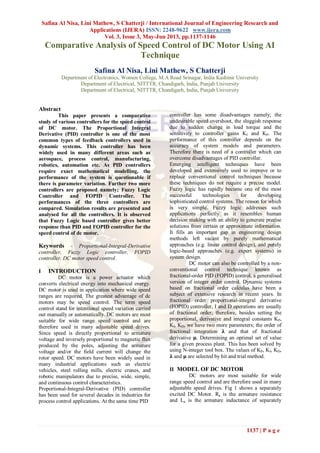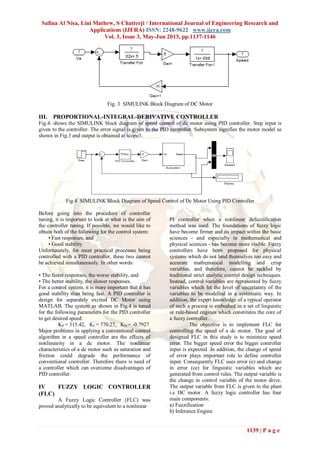This paper presents a comparative analysis of speed control methods for DC motors, focusing on three types of controllers: Proportional-Integral-Derivative (PID), Fuzzy Logic Controller (FLC), and Fractional-Order PID (FOPID). The study found that the FLC performs better than both the PID and FOPID controllers in terms of speed control accuracy. The paper discusses the theoretical and practical aspects of these controller designs, supported by simulation results.





![Safina Al Nisa, Lini Mathew, S Chatterji / International Journal of Engineering Research and
Applications (IJERA) ISSN: 2248-9622 www.ijera.com
Vol. 3, Issue 3, May-Jun 2013, pp.1137-1146
1142 | P a g e
The rule editor window for the Fuzzy Controller for DC Motor is as shown in Fig.7.There are 25 rules in total
combining all the above rules
Fig. 7 Rule Editor Window for Fuzzy Controller of DC Motor
V FRACTIONAL ORDER PID
CONTROLLER
A. Fractional Calculus
To study the fractional order controllers,
the starting point is of course the fractional order
differential equations using fractional calculus.
Fractional calculus extends the classic concepts of
differential and integral calculus to an arbitrary
order. For the definition of the generalized operator
aD_t (where a and t are the limits and _ is the order
of the operation), the Riemann-Liouville (RL) and
the Gr ¨unwald-Letnikov (GL) definitions are
generally applied. The RL definition is given by (_
> 0): aD_
aDt
∝
f t =
1
Γ(n−1)
dn
dtn
f(Γ)
(t−Γ)α−n+1
t
a
dΓ
where 𝛤(x) is the gamma function of f(x)
The GL definition is (α∈ℝ) u
And [x] represents the integer part of x.
The classical PID controller can be generalized into
a fractional order PID controller, the so
called PIλ
Dμ
, whose integro-differential equation
can be expressed as:
u t = Kpe t +
1
TI
D−λ
e t + TDDμ
e(t) (3)
where KP is the proportional gain, TI is the integral
time constant, TD is the derivative time constant, 𝛌
is the (non-integer) order of the integrator and μ is
the (non-integer) order of the derivative action. The
corresponding transfer function is expressed as
C S =
U(S)
E(S)
= KP(1 +
1
TISλ + TASλ
) (4)
KI = KP /TI and KD = KP · TD, we obtain
C s = KP +
KI
Sλ + Kdsλ
(4.27)
It turns out in any case that in the
PIλ
Dμ
controller, there are five parameters to tune
and, most of all, the physical meaning of the two
additional parameters is not clear. Indeed, the effect
of changing these two parameters on the obtained
performance is not well understood.
B. Controller Scheme
The control scheme considered is shown
in Fig.8 where C and P are the controller and the
process transfer functions respectively, x is the
process output, y is the measured output, u is the
control variable, r is the reference signal and e =
r−y is the control error. Then, d denotes the load
disturbance signal and n denotes the measurement
noise signal. It is worth stressing that the
performance of the control system in general is
evaluated by considering all the input-output
relationships between the three inputs r, d and n,
and the three outputs y, x and u.
Fig. 8 Control scheme of FO PID
For the purpose of the description made in the
following sections, denote as S the sensitivity
function
S(s) =
1
1+C S P(S)
(5)
as T the complementary sensitivity function
T s =
C s P(s)
1+C s P(s)
(6)
and as L the open-loop transfer function
L(s) = C(s) P(s)
C. Design of FOPID Controller for Speed
Control of Dc Motor
Fig.9 shows the SIMULINK model for
speed control of separately excited dc motor using
FOPID Controller. Subsystem shows the model of
separately excited DC Motor as shown in Fig.1.](https://image.slidesharecdn.com/gl3311371146-130606024802-phpapp01/85/Gl3311371146-6-320.jpg)


![Safina Al Nisa, Lini Mathew, S Chatterji / International Journal of Engineering Research and
Applications (IJERA) ISSN: 2248-9622 www.ijera.com
Vol. 3, Issue 3, May-Jun 2013, pp.1137-1146
1145 | P a g e
the better performance of the system with the
Fuzzy Logic controller was observed. Fractional
order PID controller for integer order plants offer
better flexibility in adjusting gain characteristics
than the PID controllers, owing to the two extra
tuning parameters i.e. order of integration and order
of derivative in addition to proportional gain,
integral time and derivative time. Fine-tuned Fuzzy
controller presents smaller overshoot and settling
time than conventional PID controller and FOPID
controller. The three parameters "KP", "KI", "KD"
of conventional PID control need to be constantly
adjusted in order to achieve better control
performance. In case of fractional PID five
parameters needs to be tuned to achieve better
performance. Fuzzy self-tuning PID parameters
controller can automatically adjust PID parameters
in accordance with the speed error and the rate of
speed error-change, so it has better self-adaptive
capacity. The reason for getting a smooth controller
output in the PID-like FLC case is because of the
fact that PID-like FLC updates the controller output
by making comparison of the error and the change
in error in angular displacement of the motor shaft.
REFRENCES
[1] Zhang G and Funji Furusho Fungi, “Speed
Control of Two-Inertia System by PI/PID
Control”, IEEE Transaction on Industrial
Electronics, Vo1. 47, pp. 603-609, June,
2000.
[2] I-Hai Lin P and Ellsworth Chris, “Design
and Implementation of a PC-Based
Universal Fuzzy Logic Controller
System”, Proceedings of International
IEEE/IAS Conference on Industrial
Automation and control, pp. 399-408, 06
August, 2002.
[3] Zadeh L.A., “Fuzzy Logic: Issues,
Contentions and Perspectives”, IEEE
International Conference on Acoustics,
Speech, and Signal Processing, VI, pp.
VI/183, Vol. 6, 19 April, 1994.
[4] Prommeuan S., Boonpiyathud S and
Suksri T, “Fuzzy Logic Based on
LabVIEW for Speed Control of Two-
Inertia System”, Proceedings of
International Joint Conference by the
Institute of Control, Robotics and Systems
(ICROS) and the Society of Instrument
and Control Engineers (SICE) on
Industrial Electronics, pp. 2867-2870,
August, 2009.
[5] Tipsuwan Y., Mo-Yuen Chow, “Fuzzy
logic Microcontroller Implementation for
DC Motor Speed Control”,
Proceedings of International IEEE
Conference on Industrial Electronic
Society, Vol. 3, pp. 1271-1276, 29
November, 1999.
[6] Sousa G.C.D and Bose B.K, “A Fuzzy Set
Theory Based Control of a Phase-
Controlled Converter DC Machine Drive”
IEEE Transaction on Industrial
Applications, Vol. 30, pp. 34-44, January,
1994.
[7] Katbab A., “Fuzzy Logic and Controller
Design-a Review”, Proceedings of IEEE
Conference on Visualize the Future, pp.
443-449, March, 1995.
[8] Wen J. Sheng Wang C. Hsu; Chang Y.
De; Teng C. Cheng., “Intelligent Control
of High-speed Sensorless Brushless DC
Motor for Intelligent Automobiles”,
Proceedings of IEEE Conference on
System, Man and Cybernetic, pp. 3394-
3398, October, 2008.
[9] N. Barakat., “Speed Control of a DC
Motor using a Feedforward Computed
Torque Control Scheme”, Proceedings of
IEEE Conference on Intelligent Control,
pp. 432-437, September, 1996.
[10] Khoei A., Hadidi Kh. and Yuvarajan S.,
“Fuzzy-Logic DC-Motor Controller with
Improved Performance”, Proceedings of
IEEE Conference on Industry
Applications, Vol. 3, pp. 1652-1656,
October, 1998.
[11] Altayef J. A. and Zhu Qun-xiong, “Real –
Time DC Motor Position Control by
(FPID) Controllers and Design (FLC)
Using LabVIEW Software Simulation”,
Proceedings of International Conference
on Computer and Automation Engineering
held in Singapur, Vol. 2, pp. 417-420, 26
February, 2010.
[12] Mrad F., DandachS H., Azar S.and Deeb
G., “Operator-Friendly Common Sense
Controller with Experimental Verification
using LabVIEW”, Proceedings of IEEE
International Symposium on Control and
Automation, pp. 1051-1055, June, 2005.
[13] Huibin Z., Jianxun Jin and Jun Cheng,
“Virtual Instrument Based Fuzzy Control,
System form PMLSM Drive” Proceedings
of IEEE International Conference on
Applied Superconductivity and
Electromagnetic Devices, pp. 299-303, 25
September, 2009.
[14] Khuntia S.R., Mohanty K.B., Panda S and
Ardil C, “A Comparative Study of P-I, I-
P, Fuzzy and Neuro-Fuzzy Controllers for
Speed Control of DC Motor Drive”,
Proceedings of International Journal on
Electrical and Computer Engineering, Vol.
5, pp. 287-291, 2010.](https://image.slidesharecdn.com/gl3311371146-130606024802-phpapp01/85/Gl3311371146-9-320.jpg)
![Safina Al Nisa, Lini Mathew, S Chatterji / International Journal of Engineering Research and
Applications (IJERA) ISSN: 2248-9622 www.ijera.com
Vol. 3, Issue 3, May-Jun 2013, pp.1137-1146
1146 | P a g e
[15] Natsheh E and K. A Buragga A.K.,
“Comparison between Conventional and
Fuzzy Logic PID Controllers for
Controlling DC Motors”, Proceedings of
International Journal on Computer Science
Issues, Vol.7, pp. 1694-0814, September,
2010.
[16] Zhao Chunna., Xue Dingy U and Chen
Y.Q., “A Fractional Order PID Tuning
Algorithm for A Class of Fractional Order
Plants” Proceedings of American Control
Conference, Minneapolis, pp. 3182-3187,
June, 2006.
[17] Kaur K., Chowdhury S. and Domijan A.,
“Fuzzy Logic Based Control of Variable
Speed Induction Machine Wind
Generation System", Proceedings of IEEE
Conference on Conversion and Delivery
of Electrical Energy, pp. 1-11, July, 2008.
[18] Ponce P., Ramirez F. and Medina V., “A
Novel Neuro-Fuzzy Controller Genetically
Enhanced Using LabVIEW”, Proceedings
of IEEE Annual Conference on Industrial
Electronics, pp. 1559-1565, 2008.
[19] Ismail A and Sharaf A.M., “An Efficient
Neuro Fuzzy Speed Controller for Large
Industrial DC Motor Drive”, Proceedings
of IEEE International Conference on
Control Application, Vol.2, pp. 1027-
1031, 10 December, 2002.
[20] Bimal B.K., “Expert System, Fuzzy Logic,
and Neural Network Applications in
Power Electronics and Motion Control”,
Proceedings of International journals, Vol.
82, pp. 1303-1323, August, 1994.
[21] Mountain J.R., “Fuzzy Logic Motor Speed
Control with Real-time Interface using an
8-bit Embedded Processor”, Proceedings
of IEEE Symposium on System Theory
(SSST), pp. 307-312, 7 March, 2010.
[22] Aceves Lopez A and Aguilar-Martin J, “A
Simplified Version of Mamdani's Fuzzy
Controller: the natural logic controller”,
Proceedings of IEEE International
Conference on Computational Intelligence
Society, Vol.14, pp. 16-30, 13 February,
2006.
[23] Pisoni E., Visioli. A and Dormido. S, “An
Interactive Tool for Fractional Order PID
Controllers”, Proceedings of IEEE
Annual Conference on Industrial
Electronics, held in Italy, pp. 1470-1475,
2009.
[24] Bingul. Z and Karahan. O, “Tuning of
Fractional PID Controllers using PSO
Algorithm for Robot Trajectory Control”
IEEE International Conference on
Mechatronics (ICM), pp. 955-960, 13
April, 2011.
[25] Yang Ding, Bin Sun, Yongmei Huang,
Weiwei Lin and Fei Qian, “Hybrid
MATLAB and LabVIEW to Implement an
Intelligent Foundation Field bus Control
System”, Proceedings on Intelligent
Control and Automation, pp. 4539-4543, 7
July, 2010.
[26] Sundaravadivu. K., B. Arun and
Saravanan K., “Design of Fractional Order
PID Controller for Liquid Level Control
of Spherical Tank”, Proceedings of IEEE
International Conference on Control
System, Computing and Engineering
(ICCSCE), pp. 291-295, 25 November,
2011.
[27] Hamamci S.E., “An Algorithm for
Stabilization of Fractional-Order Time
Delay Systems Using Fractional-Order
PID Controllers”, IEEE Transactions on
Automatic Control, Vol.52, pp. 1964–
1969, October, 2007.
[28] Wang. Z., Cao. G and Zhu. X., “Digital
Implementation of Fractional Order PID
Controller, and its Application”
Proceedings of Journal on Systems
Engineering and Electronics, Vol.16,
Issue.1, pp. 116-122, March, 2005.
[29] Zang. Y. “Fractional-order PID Controller
Tuning Based on Genetic Algorithm”
Proceedings of International Conference
on Business Management and Electronic
Information (BMEI), Vol.3, pp. 764-767,
13 May, 2011.](https://image.slidesharecdn.com/gl3311371146-130606024802-phpapp01/85/Gl3311371146-10-320.jpg)